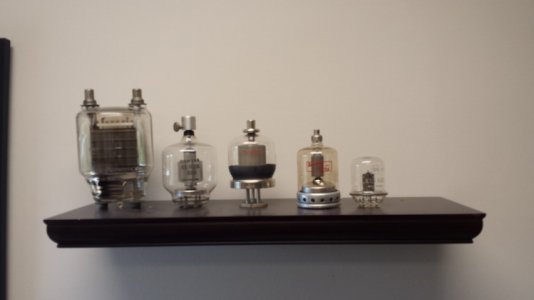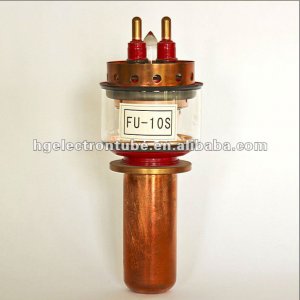Heh. A few years ago I splurged and built a *very* nice tube amp for myself. It's heavy, hot, and inefficient, unless you're using it as a space heater.
I used a 12AX7 as the input tube, and a pair of EL84 tubes as the outputs, in self-inverting push-pull operation. It makes a staggering 11 watts per channel.
Piped through a pair of Pioneer speakers (18" woofer, 4" midrange, 1" tweeter per cabinet), it is loud enough to run you right out of the house. My neighbor was amazed that 11 watts per channel could reach 'bleeding-from-every-orifice' volume levels. Quite a bit of money tied up in the amp, but it was a thoroughly enjoyable project.
Here's the shelf behind my desk at work. I have some of my collection on there. From left to right:
833A transmitting tube. This one was abused when I bought it (for display).
RS1026 - This tube has a graphite plate, and I've pushed it to bright orange-white hot, about 2kW output. (RF, not audio!)
4PR60B - This is a pulse-duty tube, .001% duty cycle. 20kV on the plate, 18A peak pulse current. It's good for about 20kW for a *VERY* short time. Scary tube.
4-125A - Eimac power tetrode. Used mainly in RF amplifiers, this one has a busted filament, so it's a display-only model.
826 - an original RCA tube, it works, but is rather delicate.
View attachment 114812
I used to have an old Russian GU10A tube. Big water-cooled beast, 7.2v 80A filament. That beast was good for 10kW continuous, and was absolutely *terrifying* to work with. The tube was about 12" long, around 4" in diameter, and weighed better than 5 lbs. Closest image is an import clone. I think it's name is appropriate, because it will mess you up. The big copper cylinder is the anode (plate). In reference, the 833A tube is about 4.5" in diameter, and 8" tall.
View attachment 114815
Sorry to hijack, but I really like tube gear.





